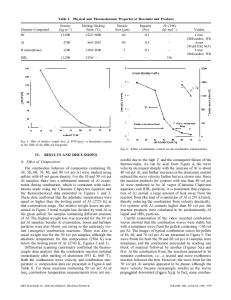Synthesis of high-strength W–Ta ultrafine-grain composites
- PDF / 689,050 Bytes
- 7 Pages / 585 x 783 pts Page_size
- 36 Downloads / 3,819 Views
S. Chauhan Department of Aerospace Engineering, Iowa State University, Ames, Iowa 50011
D.J. Sordelet Materials and Engineering Physics Program, Ames Laboratory (United States Department of Energy), Ames, Iowa 50011 (Received 20 June 2007; accepted 20 September)
Bulk samples of an ultrafine-grained tungsten–tantalum composite alloy have been synthesized by consolidating mechanically milled composite powders. The grain growth during densification is limited due to the submicron-scale layering of the individual metals in the composite particles and the relatively low sintering temperature (1300 °C). The ultrafine microstructure of the high-density (∼99% theoretical density) samples leads to a high yield stress of ∼3 GPa under quasi-static uniaxial compression. A tendency for Ta-rich solid-solution formation during densification was observed, and the high-temperature phase equilibria in the composite powders were examined further using high-energy x-ray diffraction at temperatures up to 1300 °C.
I. INTRODUCTION
The deformation behavior of metals and alloys is strongly dependent on their grain size.1 For example, nanograin (NG) and ultrafine-grain (UFG) metals often exhibit plastic instability in the form of shear banding, which is not prevalent in their coarse-grained forms due to stabilizing mechanisms such as strain and strain-rate hardening.2–5 Shear banding is of particular importance for applications such as high-speed machining where the “self-sharpening” behavior at high strain rates is desirable for more rapid and precise material removal.6,7 The tendency for shear-band formation during compressive loading has been observed in both elemental3,4,8 and alloy9 systems. Various bulk-processing methods have been used to achieve NG and UFG structures, but most may be classified into two distinct approaches. The first involves reducing the grain size of a monolithic component through extensive plastic deformation,10 while the second encompasses the densification of powders (i.e., powder metallurgy) that already contain very fine-grain sizes.11 Materials produced by either technique are naturally sensitive to grain growth at high temperatures, particularly elemental systems. Moreover, the high temperatures needed to fully densify powders can rapidly
a)
Address all correspondence to this author. e-mail: [email protected] DOI: 10.1557/JMR.2008.0007 J. Mater. Res., Vol. 23, No. 1, Jan 2008
http://journals.cambridge.org
Downloaded: 14 Mar 2015
eliminate the previous NG or UFG structure in the starting powders. To a certain extent, the driving force for grain growth during sintering may be mitigated by synthesizing powders having a fine-scale, intimate mixture of different phases. In this article, we report on the mechanical milling of W and Ta to form composite powders that retain their UFG structures after densification by hot isostatic pressing. The high-density samples exhibit limited grain growth due to the combination of the submicronscale layering of W and Ta in the particles and the solidsolution formation a
Data Loading...











